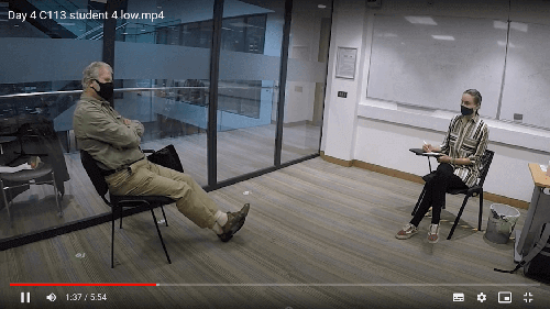COMMUNICATION SKILLS PROJECT – USING INNOVATION WHEN FACED WITH LIMITATIONS
Overview
This Learning Enhancement project has been funded through the HEA and the National Forum for the Enhancement of Teaching and Learning.
| PROJECT TITLE: | Communication Skills Project - Using Innovation when faced with limitations |
|---|---|
| PROJECT COORDINATORS: | Nicola Walshe |
| COLLABORATORS: | Dr. Emmet Kelly, Pamela Kelly |
| MODULE/PROGRAMME: | Veterinary Medicine Programme (MVB) |
| STUDENT COHORT: | Stage 1 - 3 undergraduates |
Background
The overall objective of the project was the development of an online open access, interactive, communication video repository that would offer the opportunity to build from the basics to the complexities of communication in the professional field of veterinary medicine, but also have elements relatable to veterinary nursing other medical disciplines.
To ensure the teaching of effective communication, this project aimed to create interactive content that is outcome driven with a dynamic helical model approach. The objectives were engineered to be in line with the requirements of the professional growth curriculum, with step by step development from stage one through to stage four.
We wanted to provide an online platform that was easily accessible for students and in particular, could be used as to prepare students for engagement and participation in communication skills simulation with trained actors that are pre-existing core curricular components in the Professional Growth modules in stages three and four of the MVB program.
Goals
There were four overall objectives of the project as outlined below:
- Objective 1 – To develop an interactive forum describing the basics of communication i.e. videos highlighting the importance of body language and non-verbal cues.
- Objective 2 – To develop an interactive forum highlighting the skills involved in good client communication with a focus on the consultation process.
- Objective 3 – To develop videos highlighting poor communication, with a specific focus on consulting technique, to be used as workshop group-based learning resource.
- Objective 4 – To expand the communication video resource to develop skills of dynamism when faced with challenging scenarios.
The Innovative Approach
Approach for objective 1
Due to covid restrictions and because students were emersed in the world of zoom/teams for workshop teaching and group work, we felt a communication video regarding virtual communication was both timely and necessary. We worked with a group of students to simulate a group work interaction and highlight the importance of engagement, body language and demeanour even when on a virtual platform (zoom in this case).
Approach for objectives 2 and 3
Originally, we had hoped to create simulated sessions with actors as outlined above in objectives 2 and 3, however, due to the restrictions our facilitated simulated communicated workshop format had to change and below outlines how we took advantage of this crisis to create very relevant and tangible content for the students.
The Calgary-Cambridge model for communication skills development within the professionalism strand. Previously this was taught through one face-to-face, three-hour, small group session the students prepare as a group for each individual simulated client consultation. However, because of the equipment (go-pros) purchased using the LEP funding, the one-to-one client consultation was video recorded to enable personal review and facilitated group reflection.
Results
Results for objective 1
The students created a very realistic and relative video using a script that was developed by the professional growth communications team with input and adaptation from the students. Poor communication, such as disengaged body language, stern facial expressions, over-talking, checking emails or phones were all highlighted. This is now used in the PG1 course for students to analyse and reflect upon.
Results for objectives 2 and 3

The video recording allowed each student the opportunity to review and reflect on their consultation, leading to more accurate and in-depth performance analysis. Also, with the permission of the students (GDPR compliant), we asked ten students who showed impressive communication skills if we could keep their videos on file to create and online repository.
This in fact provided us with a much more realistic and relevant communication resource. Ultimately, we hope to use this repository as both a teaching tool as well as a resource for students. Firstly, we can give the students the relevant scenarios related to the videos and allow them to create questions etc that would be useful in the consult. Secondly, the student can critique the performance of the acting student and reflect as to what they would do differently. Finally, it allows students to get a sense of what was expected from them in their workshop, which can often quell anxiety and apprehension regarding the experience.
Resources
References
- Kurtz, S., Silverman, J., Benson, J. and Draper, J. (2003) Marrying content and process in clinical method teaching: Enhancing the Calgary-Cambridge guides. Acad. Med. 78, 802–809.
- Chiau, T.P., Ali, A.M., Bakry, M.M., Azmi, N. and Paraidathatu, T. (2016) Video recording feedback in communication and counseling among pharmacy students. Is it better than verbal feedback? Indian J. Pharm. Educ. Res. 50, 246–250. Accessed December 10, 2020.